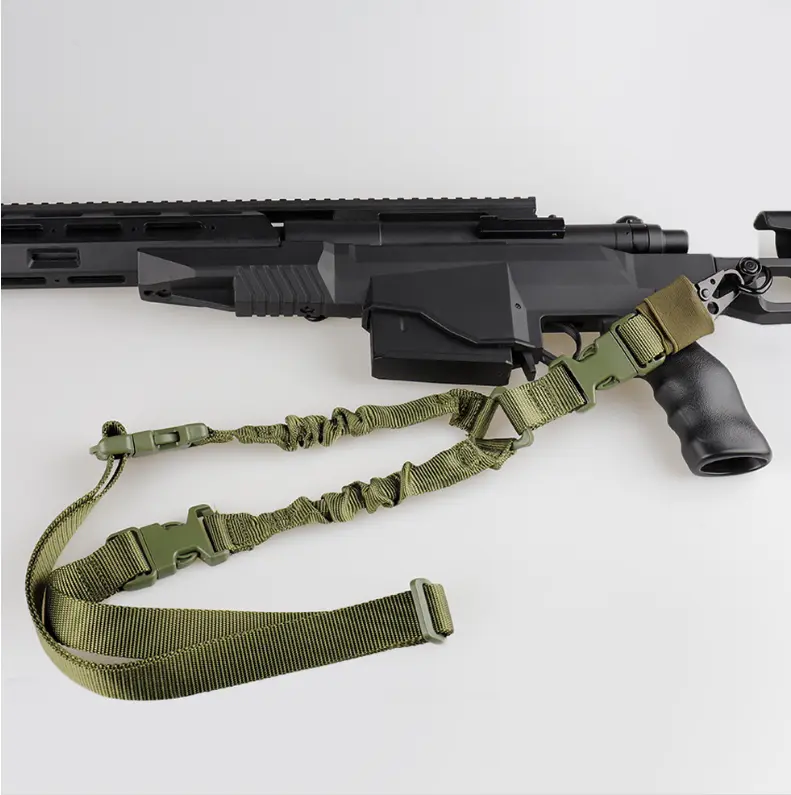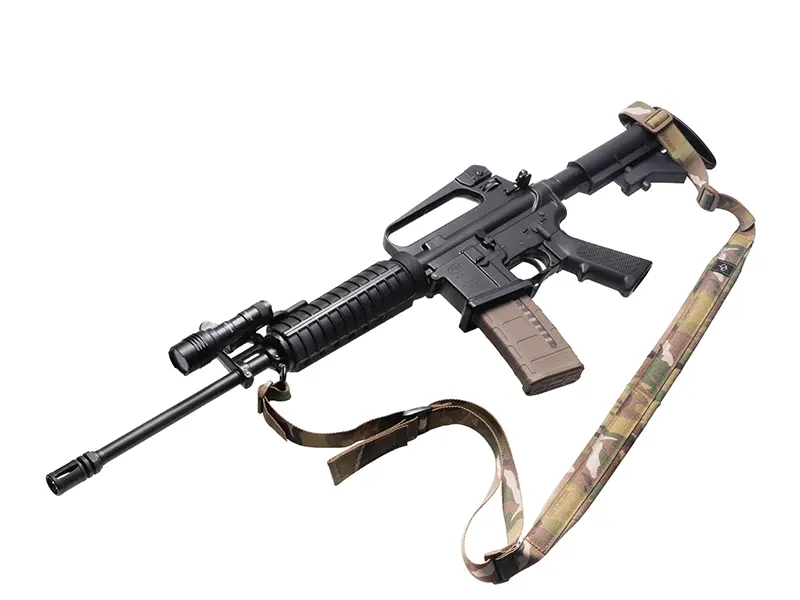In the world of tactical gear, a gun sling is a fundamental piece of equipment. It's more than just a strap; it's a critical tool for weapon retention, stability, and readiness. For tactical gear brands and manufacturers, the choice of webbing for these slings is a decision that directly impacts product performance, durability, and user trust. A sling is only as strong as its weakest link, and very often, that link is the webbing itself.
As a webbing manufacturer with over 20 years of experience supplying materials for the military and tactical industry, we understand that not all webbing is suitable for this demanding application. This guide provides a deep dive into the best materials for gun slings, helping you make an informed sourcing decision for your products.
Key Performance Requirements for Gun Sling Webbing
Before comparing materials, it's essential to understand what makes webbing suitable for a high-performance gun sling. Whether it's a single-point, two-point, or convertible sling, the webbing must deliver on several fronts:
- Tensile Strength: It must be strong enough to support the full weight of a firearm and accessories under dynamic stress without risk of failure.
- Abrasion Resistance: The webbing will constantly rub against gear, buckles, and the user's clothing. High abrasion resistance prevents fraying and ensures a long service life.
- Weather & UV Resistance: Exposure to sun, rain, and humidity can degrade webbing over time. The material must maintain its integrity in various environmental conditions.
- Feel and Flexibility: The webbing should be pliable enough to move with the user without being too soft or flimsy, which could cause twisting and snagging.
Material Showdown: What is the Best Material for Rifle Slings?
The two primary contenders for modern tactical slings are Nylon and Polyester. While they may look similar, their inherent properties make them suitable for slightly different performance objectives.
| Material | Key Characteristics & Performance | Ideal Use Case |
|---|---|---|
| Nylon Webbing | Considered the industry standard for high-end tactical gear. Nylon offers exceptional abrasion resistance and superior tensile strength. It has a slight natural stretch, which can help absorb shock during dynamic movements. Its smooth, comfortable feel is preferred for applications with direct skin or clothing contact. | The top choice for heavy-duty, mission-critical gun slings where durability and a comfortable "hand" are paramount. Perfect for military, law enforcement, and premium tactical brands. |
| Polyester Webbing | Polyester's main advantages are its low elongation (it doesn't stretch, even when wet) and excellent resistance to UV rays and water. This makes it incredibly stable in outdoor and marine environments. While strong, its abrasion resistance is generally considered slightly lower than that of high-tenacity nylon. | Excellent for slings used in consistently wet or high-sun environments, such as hunting or maritime operations. Also a great choice for applications where color stability over time is a primary concern. |
Manufacturer's Note: For the majority of high-performance tactical gun slings, Nylon is the preferred material due to its unparalleled blend of strength, abrasion resistance, and user comfort. However, for specific needs like camouflage patterns, polyester is often the better base, as we explain in our guide to camouflage webbing.
Mil-Spec Webbing: The Unquestionable Gold Standard
When sourcing for tactical applications, you will inevitably encounter the term "Mil-Spec." This isn't just marketing jargon; it refers to a set of strict manufacturing standards defined by the U.S. Department of Defense. Using Mil-Spec webbing ensures a level of quality, consistency, and durability that commercial standards often cannot guarantee.
For gun slings, two common specifications are:
- MIL-W-17337: A highly durable and flexible nylon webbing, known for its thin profile and exceptional strength. It's a popular choice for slings and straps on MOLLE systems.
- A-A-55301: A similar specification that often replaces MIL-W-17337, offering a flat weave that is also incredibly strong and abrasion-resistant.
Choosing between these often comes down to the specific requirements of a contract or design preference. You can learn more about their subtle differences in our detailed comparison, MIL-W-17337 vs. A-A-55301.
Beyond Material: Weave and Width Matter
The construction of the webbing also plays a vital role. For gun slings, a flat weave is most common, but some designs incorporate tubular webbing for padded sections, as its hollow structure is softer and can encase foam. For a deeper understanding, our guide on Flat vs. Tubular Webbing can help you decide.
Common widths for gun slings are 1 inch, 1.25 inches, and 1.5 inches. The choice depends on the desired balance between weight, comfort, and compatibility with standard tactical hardware.

Order These Materials in Action
We use the same high-quality webbing discussed in this guide to build our own line of finished tactical gun slings—available now with no minimum order quantity.
View Our Finished Gun Slings →Conclusion: Your Sling's Foundation is Our Expertise
The webbing you choose is the foundation of your gun sling's performance and your brand's reputation. A sling built with high-tenacity, mil-spec compliant nylon webbing will outperform and outlast one made from inferior materials every time. It's a critical component that ensures reliability when it matters most, much like the webbing used in a durable military belt.
If you are developing a line of tactical gun slings and need a reliable supplier for high-quality webbing, your search ends here. We provide certified materials, consistent quality, and the expertise to help you select the perfect webbing for your specific application.
Contact TMG Webbing today to request samples or discuss your custom webbing requirements. Let's build gear that instills confidence.

